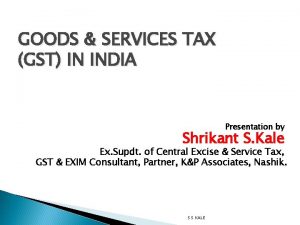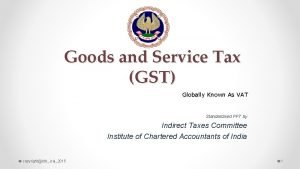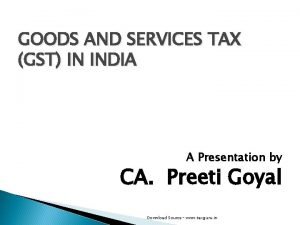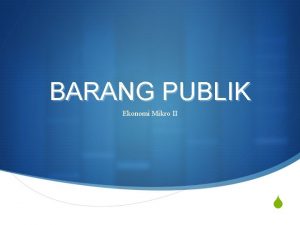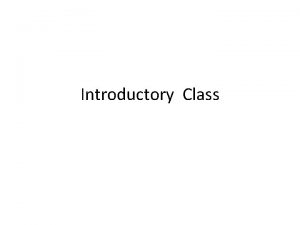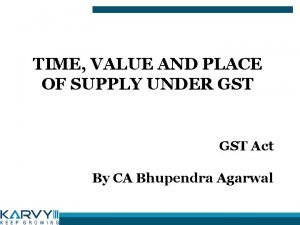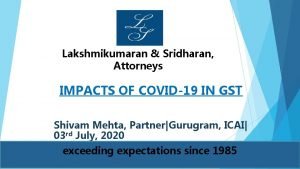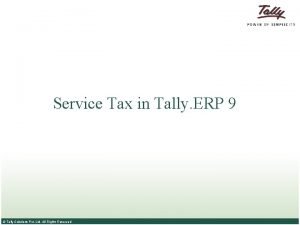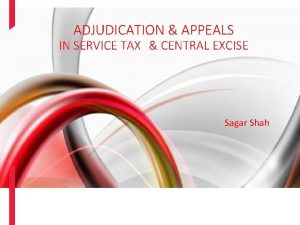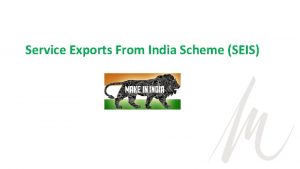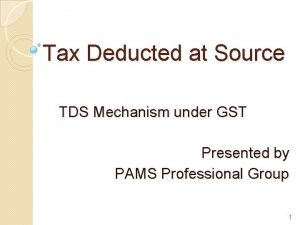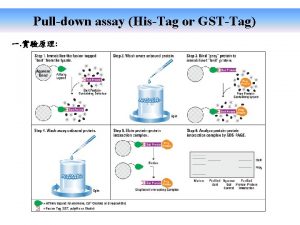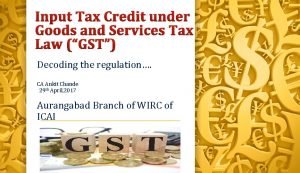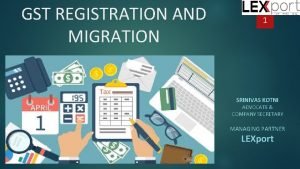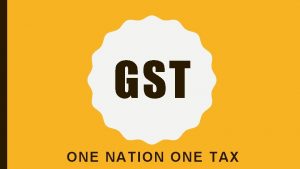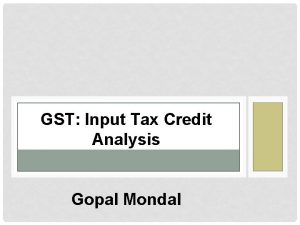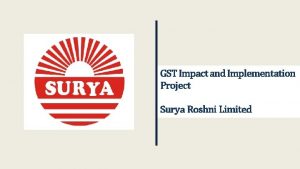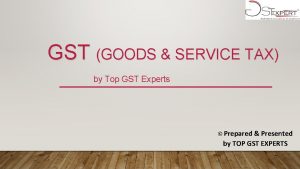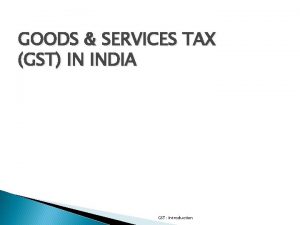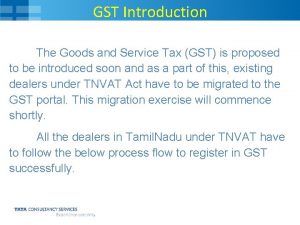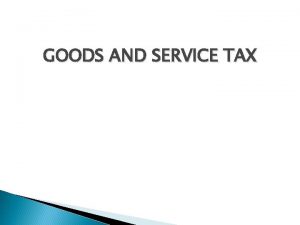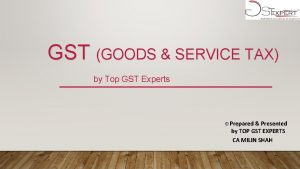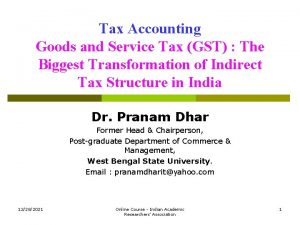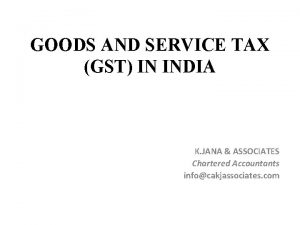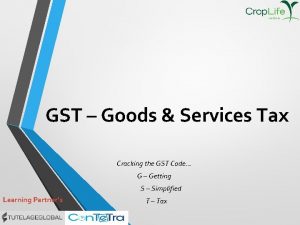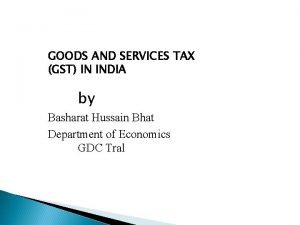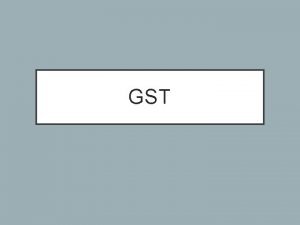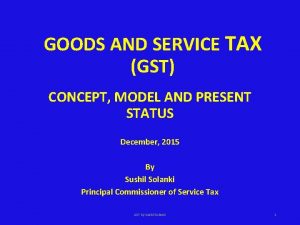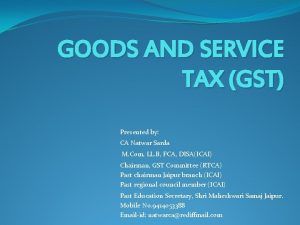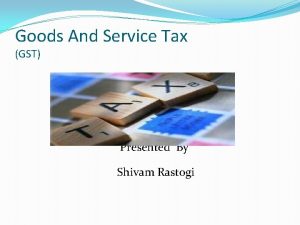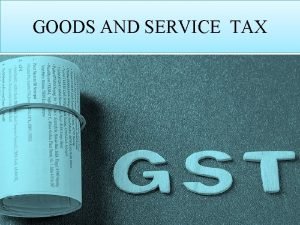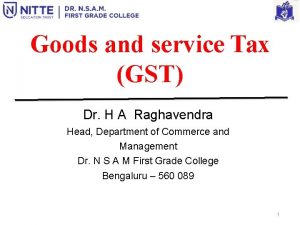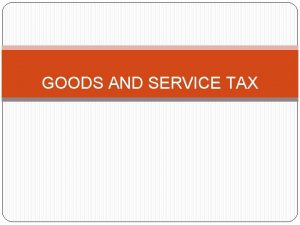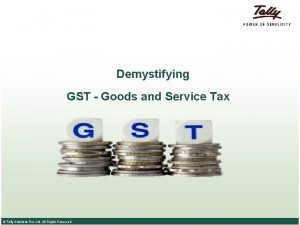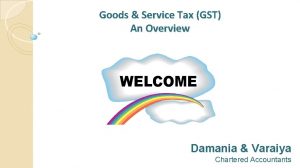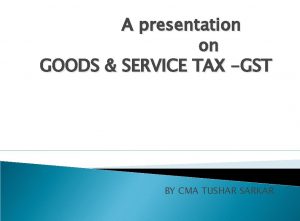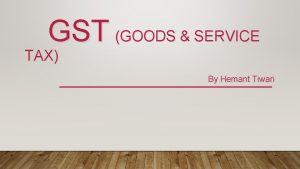GOODS AND SERVICE TAX GST IN INDIA K

























- Slides: 25

GOODS AND SERVICE TAX (GST) IN INDIA K. JANA & ASSOCIATES Chartered Accountants info@cakjassociates. com

CONCEPT OF GST • • GST is a tax on goods and services with comprehensive and continuous chain of setoff benefits from the Producer’s point and Service provider’s point up to the retailer level. GST is expected be levied only at the destination point, and not at various points (from manufacturing to retail outlets). It is essentially a tax only on value addition at each stage and a supplier at each stage is permitted to setoff through a tax credit mechanism which would eliminate the burden of all cascading effects, including the burden of CENVAT and service tax. • Under GST structure, all different stages of production and distribution can be interpreted as a mere tax pass through and the tax essentially sticks on final consumption within the taxing jurisdiction. • Currently, a manufacturer needs to pay tax when a finished product moves out from the factory, and it is again taxed at the retail outlet when sold. The taxes are levied at the multiple stages such as CENVAT, Central sales tax, State Sales Tax, Octroi, etc. will be replaced by GST to be introduced at Central and State level.

CONCEPT OF GST • All goods and services, barring a few exceptions, will be brought into the GST base. There will be no distinction between goods and services. • Under GST, the taxation burden will be divided equitably between manufacturing and services, through a lower tax rate by increasing the tax base and minimizing exemptions. • However, the basic features of law such as chargeability, definition of taxable event and taxable person, measure of levy including valuation provisions, basis of classification etc. would be uniform across these statutes as far as practicable. • The existing CST will be discontinued. Instead, a new statute known as IGST will come into place on the inter-state transfer of the Goods and Services. • By removing the cascading effect of taxes (CST, additional customs duty, surcharges, luxury Tax, Entertainment Tax, etc. ), CGST & SGST will be charged on same price.

Present Tax structure Tax Structure Direct Tax Income Tax Indirect Tax Wealth Tax Central Tax Excise Service Tax State Tax Customs VAT Entry Tax, luxury tax, Lottery Tax, etc.

Proposed Tax Structure Indirect Tax = GST (Except customs) Direct Tax Income Tax Wealth Tax Intra- state CGST (Central) SGST (State) Inter State IGST (Central)

Taxes to be subsumed CGST SGST • Central Excise • Additional duties of Custom (CVD) • Service Tax • Surcharges and all cesses • VAT/sales tax • Entertainment Tax • Luxury Tax • Lottery Tax • Entry Tax/ Octroi • Purchase Tax IGST • CST

GST MODEL • SGST and CGST for intrastate transaction : In the GST system, both Central and State taxes will be collected at the point of sale. Both components (the Central and State GST) will be charged on the manufacturing cost. This will benefit individuals as prices are likely to come down. Lower prices will lead to more consumption, thereby helping companies. • IGST for Interstate transaction: ‘IGST Model’ will be in place for taxation of inter State transaction of Goods and Services. The scope of IGST Model is that center would levy IGST which would be CGST plus SGST on all inter State transactions of taxable goods and services with appropriate provision for consignment or stock transfer of goods and services. • The GST paid on the purchase of goods and services, to be paid on the supply of goods and services. • There should be no distinction between raw materials and capital goods in allowing input tax credit. The tax base should comprehensively extend over all goods and services up to final consumption point on value addition. • Assessable value for all the taxes will be same.

Stakeholder in Business Chain 1. Manufacturer 5. Government and Banks 2. Wholesaler Goods + Services 4. Consumer 3. Retailer

Chain in GST Manufacturer • Input Credit of Goods+ services • After taking set off of Input credit, pay the Output Liability on value addition Wholesaler • Input Credit of Goods+ services from manufacturer • After taking set off of Input credit, pay the Output Liability on value addition Retailer • Input Credit of Goods+ services from wholesaler • After taking set off of Input credit, pay the Output Liability on value addition Consumer • Ultimate Output Liability recovered from consumer

Set-off Mechanism • Since the Central GST and State GST are to be treated separately, in general, taxes paid against the Central GST shall be allowed to be taken as input tax credit (ITC) for the Central GST and could be utilized only against the payment of Central GST. The same principle will be applicable for the State GST. • Cross utilization of ITC between the Central GST and the State GST would, in general, be allowed. • ADC paid on Import of goods and service would fall under the IGST and this duty would be allowed for setoff of SGST and CGST.

Set off sequence in GST Input CGST Input SGST Input IGST Output CGST Output

Mechanism of Dual Taxation After introduction of GST, all the traders including manufacturer will be paying both the types of taxes i. e. CGST and SGST. The Central GST and the State GST would be levied simultaneously on every transaction of supply of goods and services except the exempted goods and services, goods which are outside the purview of GST and the transactions which are below the prescribed threshold limits. Further, both would be levied on the same price or value unlike State VAT which is levied on the value of the goods inclusive of CENVAT, i. e CGST & SGST will be charged on same price • Supply of Goods: Suppose the rate of CGST is 10% and that of SGST is 10%. When a wholesale dealer of steel in West Bengal supplies steel bars and rods to a construction company, which is also located within the same State for , say Rs. 100, the dealer would charge CGST of Rs. 10 and SGST of Rs. 10 in addition to the basic price of the goods. • Supply of Services : Suppose, that the rate of CGST is 10% and that of SGST is 10%. When an advertising company located in Kolkata supplies advertising services, to a company manufacturing soap which is also located within the State of West Bengal for, Rs. 100, then the ad company would charge CGST of Rs. 10 as well as SGST of Rs. 10 to the basic value of the service. In both the cases, he would be required to deposit the CGST component into a Central Government account and the SGST portion into concerned State Government account. He need not actually pay duty in cash, as he would be entitled to set-off this liability against the CGST or SGST paid on his purchases (say, inputs). But for paying CGST he would be allowed to use only the credit of CGST & SGST paid on his purchases respectively. In other words, CGST credit cannot, in general, be used for payment of SGST. Nor can SGST credit be used for payment of CGST.

GST on Import of Goods and services • With Constitutional Amendments, both CGST and SGST will be levied on import of goods and services into the country. • The incidence of tax will follow the destination principle(Place of supply rules). • Tax revenue in case of SGST will accrue to the State where the imported goods and services are consumed. • Full and complete set-off will be available on the GST paid on import on goods and services. • Thus, import of goods will attract BCD and IGST. It may be noted that import of services, as against service tax at present, in GST regime, will attract IGST. • Basic Custom Duty will continue to there under GST system. However, the additional custom duty in lieu of CVD /Excise and the Special Additional Duty (SAD) in lieu of sales tax/VAT will be subsumed in the import GST. • The import of services will be subject to Central GST and State GST on a reverse charge mechanism. In other words, the GST will be payable by the Importer on a self declaration basis.

Taxable Person • It will cover all types of person carrying on business activities, i. e. manufacturer, job-worker, trader, importer, exporter, all types of service providers, etc. • If a company is having four branches in four different states, all the four branches will be considered as TP (Taxable person) under each jurisdiction of SGs. • A dealer must get registered under CGST as it will make him entitle to claim ITC of CGST thereby attracting buyers under B 2 B (Business to Business) transactions. • Importers have to register under both CGST and SGST as well.

• • GST on Export of Goods and Services GST on export would be zero rated. Similar benefits may be given to Special Economic Zones (in processing zones only). No benefit to the sales from an SEZ to Domestic Tariff Area (DTA). GST paid by Exporter on the procurement of goods and services will be refunded.

Registration under GST • Each taxpayer would be allotted a PAN linked taxpayer identification number with a total of 13/15 digits. • This would bring the GST PAN-linked system in line with the prevailing PAN-based system for Income tax facilitating data exchange and taxpayer compliance. • Existing VAT/Central excise/Service Tax payers will not have to apply afresh for registration under GST. • Single application to be filed online for registration under GST by New Dealer.

Returns under GST • Filing of returns would only be through online mode. Facility of offline generation and preparation of returns will also be available. The returns prepared in the offline mode will have to be uploaded. • There will be a common e-return for CGST, SGST, IGST and Additional Tax. • A registered Tax Payer shall file GST Return at GST Common Portal either by himself or through his authorised representative; • There would be no revision of Returns. Changes to be done in subsequent Returns

Returns under GST (contd. ) • Outward supplies made by taxpayer (other than compounding taxpayer and ISD) with in 10 th of the next month. • Inward supplies received by a taxpayer (other than a compounding taxpayer and ISD) with in 15 th of the next month. • Monthly return (other than compounding taxpayer and ISD) with in 20 th of next month.

Returns under GST (contd. ) • Quarterly return for Compounding Taxpayer with in 18 th of the month next to quarter. • Return for Input Service Distributor (ISD) with in 15 th of the next month. • GST Annual Return with in 31 st December of next financial year.

Taxable Event Existing Practice GST Taxable event is “Supply “ of Goods & service Excise Duty-Manufacturing, The location of the supplier and the recipient within the country is immaterial for the purpose of CGST. Sales Tax/VAT- Sale of Goods Service Tax- Realization of Service SGST would be chargeable only when the supplier and the recipient are both located within the State. Inter state Supply of goods and services will attract IGST.

Rate of Tax Rate of GST as per GST council meeting held in Nov’ 16: • • • Essential items including food : 0% Common use items : 5% Standard Rates : 12% & 18& Items currently taxable (30 -31%) : 28% Luxury and de-merits goods : 28%(+ cess) This is rates are subject to change

Exemption from GST Alcohol, tobacco, petroleum products are likely to be out of the GST regime. Tax on items containing Alcohol: Alcoholic beverages would be kept out of the purview of GST. Sales Tax/VAT could be continued to be levied on alcoholic beverages as per the existing practice. In case it has been made VA table by some States, there is no objection to that. Excise Duty, which is presently levied by the States may not also be affected. Tax on Petroleum Products: Petroleum and petroleum products have also been constitutionally brought under the GST. However, it has also been provided that petroleum and petroleum products shall not be subject to the levy of GST till notified at a future date on the recommendation of the GST Council. Tax on Tobacco products: Tobacco products would be subjected to GST with ITC. Centre may be allowed to levy excise duty on tobacco products over and above GST with ITC. Taxation of Services: As indicated earlier, both the Centre and the States will have concurrent power to levy tax on goods and services. In the case of States, the principle for taxation of intra-State and inter 46 State has already been formulated by the Working Group of Principal Secretaries /Secretaries of Finance / Taxation and Commissioners of Trade Taxes with senior representatives of Department of Revenue, Government of India. For inter-State transactions an innovative model of Integrated GST will be adopted by appropriately aligning and integrating CGST and IGST.

Composition scheme A Composition/Compounding Scheme will be an important feature of GST, to protect the interests of small traders and small scale industries. The Composition/Compounding scheme for the purpose of GST should have an upper ceiling on gross annual turnover and a floor tax rate with respect to gross annual turnover. In particular there will be a compounding cut-off at Rs. 50 lakhs of the gross annual turnover and the floor rate of 1. 0% across the States. The scheme would allow option for GST registration for dealers with turnover below the compounding cut-off.

Increased Assessee Base • Under the CGST model proposed, with threshold of annual turnover of Rs. 20 lakhs, the present Assessee base of Excise and Service Tax of about 10 lakhs will increase to about 50 lakhs as every manufacturer and Trader above the specified threshold will be liable to CGST. • SSI exemption is reduced to Rs 20 lakhs instead of Rs. 1. 50 cr.

Flaws of GST Model • Major flaw of this model is , Local Dealers have to pay CGST in addition to SGST. • In Addition to this, CGST mainly represents the Excise/service tax and SGST mainly represents the VAT portion but, because of ‘No differentiation between Goods and Services’ service supply within the state would attract SGST as GST is levied at each stage in the supply chain and Assessee have to Pay CGST as well SGST. • The issue which still needs to be resolved are, the revenue sharing between States and Centre, and a framework for exemption, thresholds and composition.
 Before gst tax structure in india
Before gst tax structure in india Four classifications of consumer products
Four classifications of consumer products Goods and service tax
Goods and service tax Direct tax and indirect tax
Direct tax and indirect tax Progressive tax examples
Progressive tax examples Positive consumption externality
Positive consumption externality Publik goods
Publik goods Roland purcell a technical writer
Roland purcell a technical writer Product line length
Product line length Philosophy and human existence gst 113
Philosophy and human existence gst 113 Time and value of supply under gst
Time and value of supply under gst Gst168
Gst168 Service tax in tally erp 9
Service tax in tally erp 9 Cbic service tax login
Cbic service tax login Service exports from india scheme
Service exports from india scheme What is utr in gst
What is utr in gst Gst deduction at source
Gst deduction at source Annexure b for gst refund
Annexure b for gst refund Gst pull down
Gst pull down Gst 105: use of english pdf
Gst 105: use of english pdf Section 18(1)(c) of gst
Section 18(1)(c) of gst Gst suo moto cancellation revoke
Gst suo moto cancellation revoke Introduction of gst
Introduction of gst Section 18(1)(c) of gst
Section 18(1)(c) of gst Surya roshni share
Surya roshni share Gst rates on services pdf
Gst rates on services pdf
